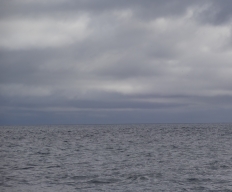
What on earth are we doing out here?
Asks Sam Llewellyn as fog becomes drizzle becomes rain...
Outside, the morning was an indistinct pearly grey. As the cabin filled with the smell of bacon, a raft of mergansers slid across the porthole, fish-eating ducks with 1950s hairstyles, pushed south from the Norwegian Arctic by the winter ice.
We shuddered our way on deck and pulled the mainsail up into the fog. The anchor chain was wet and stinging. The sail hung limp, then filled reluctantly. Out of the murk came the dull throb of invisible ferries and trawlers. We crept up the half-visible Arran shore, breath-steam billowing from the foghorn as we blew.
The forecast had mentioned wind later. For now, all there was was the cream sail fading into the grey-flannel sky, the drips from the boom making a trail of little splashes on the glassy surface, and the hypnotic murmur of the bow wave. The plotter screen showed our red arrow crawling northwest, the Clyde channel on the starboard quarter.
Shadows in the mist
In the late morning the fog became drizzle. The breeze increased, and the bow-wave's murmur became a chuckle. Two shadows in the mist sharpened into big, rusty trawlers, sullenly ploughing the wrecked seabed. We looked away.
The wind had gone westerly now. The raindrops were clumping together and beginning to lash, clattering water into the hoods of our oilskins. A gust shoved the boat hard over, and the stanchions tore white plumes from the sea.
Time for a reef. I slacked off the main halyard, stumped up on to the deck, breath roaring against my collar, pulled the luff of the mainsail down on to its hook. The burst of activity got the blood flowing again, but it did not last, and we sat in the cockpit shivering and cursing breathable oilskins that breathe in as well as out.
Teeth clatter
The reef made the boat sail more upright. We slid rapidly along the low cliffs of Bute. To port now was the gap between Arran and the Mull of Kintyre, already showing white horses on its slate-grey surface. I could hear the crew's teeth clattering like castanets. What on earth were we doing out here this late in the year?
Dark thoughts like these are usually a signal that it is lunchtime. Bang on the nose lay a turtle-shaped island. We sailed up its eastern side. In its lee the water was billiard-table smooth, the wind, broken by the island's covering of bracken, warm and aromatic. We rolled up the genoa, pointed the nose at the shore until the sounder read three metres, dropped the anchor, and pulled down the mainsail with rain-wrinkled fingers.
The cabin was warm and dry. The alcohol stove heated up baked beans on toast. Blood began to return to the extremities, and cheerfulness to the mind.
By the coffee, the hammer of the rain had become less ferocious, but the wind was moaning in the shrouds. Pull on the oilskins and go on deck. Up anchor; no jib this time, just the mainsail. We drifted astern, put the helm down until the wind hammered into the sail, and tore off northwards.
Clouds part
The clouds were higher. There were great rips and chasms in them now, and at the bottom of the chasms patches of sky bright Madonna's-robe blue. As we tore up the West Kyles a beam of pure gold lanced on to sea and hill. Suddenly there was a rainbow making an arch from shore to shore, and at its focal point a bunch of Persil-white gannets hammering down on one of the year's last shoals of mackerel.
As the big red sun went down we tied up to a big red buoy. The cooking warmed the cabin nicely. We were forced to agree that there is something to be said for late-autumn sailing after all.
Sam Llewellyn, editor The Marine Quarterly
Contact UsArticle Published: December 18, 2015 14:24